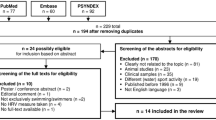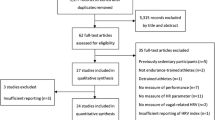Abstract
Aim is to determine if the training with heart rate variability biofeedback allows to improve performance in athletes of different disciplines. Methods such as database search on Web of Science, SpringerLink, EBSCO Academic Search Complete, SPORTDiscus, Pubmed/Medline, and PROQUEST Academic Research Library, as well as manual reference registration. The eligibility criteria were: (a) published scientific articles; (b) experimental studies, quasi-experimental, or case reports; (c) use of HRV BFB as main treatment; (d) sport performance as dependent variable; (e) studies published until October 2016; (f) studies published in English, Spanish, French or Portuguese. The guidelines of the PRISMA statement were followed. Out of the 451 records found, seven items were included. All studies had a small sample size (range from 1 to 30 participants). In 85.71% of the studies (n = 6) the athletes enhanced psychophysiological variables that allowed them to improve their sport performance thanks to training with heart rate variability biofeedback. Despite the limited amount of experimental studies in the field to date, the findings suggest that heart rate variability biofeedback is an effective, safe, and easy-to-learn and apply method for both athletes and coaches in order to improve sport performance.

Similar content being viewed by others
References
Abhishekh, H. A., Nisarga, P., Kisan, R., Meghana, A., Chandran, S., Trichur, R., & Sathyaprabha, T. N. (2013). Influence of age and gender on autonomic regulation of heart. Journal of Clinical Monitoring and Computing, 27(3), 259–264. doi:10.1007/s10877-012-9424-3.
Achten, J., & Jeukendrup, A. E. (2003). Heart rate monitoring: Applications and limitations. Sports Medicine, 33(7), 517–538.
Aubert, A. E., Seps, B., & Beckers, F. (2003). Heart rate variability in athletes. Sports Medicine, 33(12), 889–919.
Billman, G. E. (2013). The effect of heart rate on the heart rate variability response to autonomic interventions. Frontiers in Physiology, 4, 222. doi:10.3389/fphys.2013.00222.
Blumenstein, B., Bar-Eli, M., & Tenenbaum, G. (1997). A five-step approach to mental training incorporating biofeedback. The Sport Psychologist, 11, 440–453.
Boutcher, S. H., Park, Y., Dunn, S. L., & Boutcher, Y. N. (2013). The relationship between cardiac autonomic function and maximal oxygen uptake response to high-intensity intermittent-exercise training. Journal of Sports Sciences, 31, 1024–1029. doi:10.1080/02640414.2012.762984.
Buccelletti, E., Gilardi, E., Scaini, E., Galiuto, L., Persiani, R., Biondi, A., … Silveri, N. G. (2009). Heart rate variability and myocardial infarction: systematic literature review and meta-analysis. European Review for Medical and Pharmacological Sciences, 13(4), 299–307. doi:10.1002/14651858.CD006577.pub3.
Buchheit, M. (2014). Monitoring training status with HR measures: Do all roads lead to Rome? Frontiers in Physiology, 5, 73. doi:10.3389/fphys.2014.00073.
Choudhary, R., Triveti, V., & Choudary, S. (2016). Effect of heart rate variability biofeedback training on the performance of track athletes. International Journal of Therapies and Rehabilitation Research, 5(4), 166–174. doi:10.5455/ijtrr.000000159.
Cornelissen, V. A., Verheyden, B., Aubert, A. E., & Fagard, R. H. (2010). Effects of aerobic training intensity on resting, exercise and post-exercise blood pressure, heart rate and heart rate variability. Journal of Human Hypertension, 24, 175–182.
Culbert, T., Martin, H., & McCraty, R. (2004). A practitioner’s guide: Applications of the freeze-framer interactive learning system. Boulder Creek, CA: Heart Math Institute.
da Silva, F. A. K., Penachini da Costa de Rezende Barbosa, M., Marques Vanderlei, F., Destro Christofaro, D. G., & Marques Vanderlei, L. C. (2016). Application of heart rate variability in diagnosis and prognosis of individuals with diabetes mellitus: Systematic review. Annals of Noninvasive Electrocardiology: The Official Journal of the International Society for Holter and Noninvasive Electrocardiology, Inc, 21(3), 223–235. doi:10.1111/anec.12372.
de Bruin, E. I., van der Zwan, J. E., & Bögels, S. M. (2016). A RCT comparing daily mindfulness meditations, biofeedback exercises, and daily physical exercise on attention control, executive functioning, mindful awareness, self-compassion, and worrying in stressed young adults. Mindfulness, 7(5), 1182–1192. doi:10.1007/s12671-016-0561-5.
Dong, J. G. (2016). The role of heart rate variability in sports physiology. Experimental and Therapeutic Medicine, 11(5), 1531–1536. doi:10.3892/etm.2016.3104.
Eyre, E. L. J., Duncan, M. J., Birch, S. L., & Fisher, J. P. (2014). The influence of age and weight status on cardiac autonomic control in healthy children: A review. Autonomic Neuroscience, 186, 8–21. doi:10.1016/j.autneu.2014.09.019.
Eysenck, M. W., & Calvo, M. G. (1992). Anxiety and performance: The processing efficiency theory. Cognition and Emotion, 6, 409–434.
Eysenck, M. W., Derakshan, N., Santos, R., & Calvo, M. G. (2007). Anxiety and cognitive performance: Attention control theory. Emotion (Washington, D. C.), 7, 336–353.
Gevirtz, R. (2013). The promise of heart rate variability biofeedback: Evidence-based applications. Biofeedback, 41(3), 110–120. doi:10.5298/1081-5937-41.3.01.
Gross, M. J., Shearer, D. A., Bringer, J. D., Hall, R., Cook, C. J., & Kilduff, L. P. (2016). Abbreviated resonant frequency training to augment heart rate variability and enhance on-demand emotional regulation in elite sport support staff. Applied Psychophysiology and Biofeedback, 41, 263–274. doi:10.1007/s10484-015-9330-9.
Hautala, A. J., Makikallio, T. H., Kiviniemi, A., Laukkanen, R. T., Nissila, S., Huikuri, H. V., & Tulppo, M. P. (2003). Cardiovascular autonomic function correlates with the response to aerobic training in healthy sedentary subjects. American Journal of Physiology Heart and Circulatory Physiology, 285, H1747–H1752. doi:10.1152/ajpheart.00202.
Hayano, J., Yasuma, F., Okada, A., Mukai, S., & Fujinami, T. (1996). Respiratory sinus arrhythmia: A phenomenon improving pulmonary gas exchange and circulatory efficiency. Circulation, 94, 842–847. doi:10.1161/01.CIR.94.4.842.
HeartMath® Intitute. (2008). The Quick Coherence® technique for adults. Retrieved from https://www.heartmath.org/resources/heartmath-tools/quick-coherence-technique-for-adults/.
Hill, L. K., Hu, D. D., Koenig, J., Sollers, J. J., Kapuku, G., Wang, X., … Thayer, J. F. (2015). Ethnic differences in resting heart rate variability: A systematic review and meta-analysis. Psychosomatic Medicine, 77(1), 16–25. doi:10.1097/PSY.0000000000000133.
Koenig, J., & Thayer, J. F. (2016). Sex differences in healthy human heart rate variability: A meta-analysis. Neuroscience and Behavioural Reviews, 64, 288–310. doi:10.1016/j.neubiorev.2016.
Krisanaprakornkit, T., Krisanaprakornkit, W., Piyavhatkul, N., & Laopaiboon, M. (2006). Meditation therapy for anxiety disorders. Cochrane Database Systematic Reviews, 25(1), CD004998.
Lagos, L., Vaschillo, E., Vaschillo, B., Lehrer, P., Bates, M., & Pandina, R. (2008). Heart rate variability biofeedback as a strategy for dealing with competitive anxiety: A case study. Biofeedback, 36(3), 109–115.
Lagos, L., Vaschillo, E., Vaschillo, B., Lehrer, P., Bates, M., & Pandina, R. (2011). Virtual reality-assisted heart rate variability biofeedback as a strategy to improve golf performance: A case study. Biofeedback, 39(1), 15–20.
Lehrer, P. M., & Gevirtz, R. (2014). Heart rate variability biofeedback: How and why does it work? Frontiers in Psychology, 5, 756. doi:10.3389/fpsyg.2014.00756.
Lehrer, P. M., Vaschillo, E., & Vaschillo, B. (2000). Resonant frequency biofeedback training to increase cardiac variability: Rationale and manual for training. Applied Psychophysiology and Biofeedback, 25(3), 177–191.
Lehrer, P. M., Vaschillo, E., Vaschillo, B., Lu, S. E., Eckberg, D. L., Edelberg, R., … Hamer, R. M. (2003). Heart rate variability biofeedback increases baroreflex gain and peak expiratory flow. Psychosomatic Medicine, 65, 796–805. doi:10.1097/01.PSY.0000089200.81962.19.
Miu, A. C., Heilman, R. M., & Miclea, M. (2009). Reduced heart rate variability and vagal tone in anxiety: Trait versus state, and the effects of autogenic training. Autonomic Neuroscience-Basic, 145(1–2), 99–103.
Moher, D., Liberati, A., Tetzlaff, J., & Altman, D. G. (2009). The PRISMA Group. Preferred reporting items for systematic reviews and meta-analyses: The PRISMA statement. PLoS Medicine, 6(7), e1000097. doi:10.1371/journal.pmed.1000097.
Mourot, L., Bouhaddi, M., Perrey, S., Cappelle, S., Henriet, M. T., Wolf, J. P., … Regnard, J. (2004). Decrease in heart rate variability with overtraining: Assessment by the Poincaré Plot analysis. Clinical Physiology and Functional Imaging, 24(1), 10–18.
Nideffer, R.M. (1986). Concentration and attention control training. In J. Williams (Ed.), Applied sport psychology (pp. 257–269). Palo Alto: Mayfield.
Nideffer, R.M. (1989). Theoretical and practical relationships between attention, anxiety, and performance in sport. In D. Hackfort & C. D. Spielberger (Eds.), Anxiety in sport: An international perspective (pp. 117–136). New York: Hemisphere Pub. Corp.
Paul, M., & Garg, K. (2012). The effect of heart rate variability biofeedback on performance psychology of basketball players. Applied Psychophysiology & Biofeedback, 37(2), 131–144. doi:10.1007/s10484-012-9185-2.
Paul, M., Garg, K., & Sandhu, J. S. (2012). Role of biofeedback in optimizing psychomotor performance in sports. Asian Journal of Sports Medicine, 3(1), 29–40.
Prinsloo, G. E., Rauch, H. G., & Derman, W. E. (2014). A brief review and clinical application of heart rate variability biofeedback in sports, exercise, and rehabilitation medicine. The Physician and Sportsmedicine, 42(2), 88–99. doi:10.3810/psm.2014.05.2061.
Raymond, J., Sajid, I., Parkinson, L. A., & Gruzelier, J. H. (2005). Biofeedback and dance performance: A preliminary investigation. Applied Psychophysiology and Biofeedback, 30(1), 64–73. doi:10.1007/s10484-005-2175-x.
Routledge, F. S., Campbell, T. S., McFetridge-Durdle, J. A., & Bacon, S. L. (2010). Improvements in heart rate variability with exercise therapy. Canadian Journal of Cardiology, 26(6), 303–312.
Sacha, J. (2013). Why should one normalize heart rate variability with respect to average heart rate. Frontiers in Physiology, 4, 306. doi:10.3389/fphys.2013.00306.
Sandercock, G. R., & Brodie, D. A. (2006). The use of heart rate variability measures to assess autonomic control during exercise. Scandinavian Journal of Medicine & Science in Sports, 16(5), 302–313.
Sandercock, G. R. H., Bromley, P. D., & Brodie, D. A. (2005). Effects of exercise on heart rate variability: Inferences from meta-analysis. Medicine and Science in Sports and Exercise, 37(3), 433–439. doi:10.1249/01.MSS.0000155388.39002.9D.
Shiogai, Y., Stefanovska, A., & McClintock, P. V. (2010). Nonlinear dynamics of cardiovascular ageing. Physics Reports, 488(2–3), 51–110.
Tanis, C. J. (2012). Performance enhancement and stress reduction using biofeedback with women collegiate volleyball players. Athletic Insight, 4(2), 127–140.
Thayer, J. F., Åhs, F., Fredrikson, M., Sollers, J. J., & Wager, T. D. (2012). A meta-analysis of heart rate variability and neuroimaging studies: Implications for heart rate variability as a marker of stress and health. Neuroscience and Behavioural Reviews, 36(2), 747–756. doi:10.1016/j.neubiorev.2011.11.00.
Thomas, J. R., French, K. E., & Humphries, C. A. (1986). Knowledge development and sport performance: Directions for motor behaviour research. Journal of Sport Psychology, 8, 259–272.
Funding
No funding was received to perform this systematic review.
Author information
Authors and Affiliations
Corresponding author
Ethics declarations
Conflict of interest
The authors declare that they have no conflict of interest.
Ethical Approval
This article does not contain any studies with human participants or animals performed by any of the authors.
Electronic supplementary material
Below is the link to the electronic supplementary material.
Rights and permissions
About this article
Cite this article
Jiménez Morgan, S., Molina Mora, J.A. Effect of Heart Rate Variability Biofeedback on Sport Performance, a Systematic Review. Appl Psychophysiol Biofeedback 42, 235–245 (2017). https://doi.org/10.1007/s10484-017-9364-2
Published:
Issue Date:
DOI: https://doi.org/10.1007/s10484-017-9364-2




